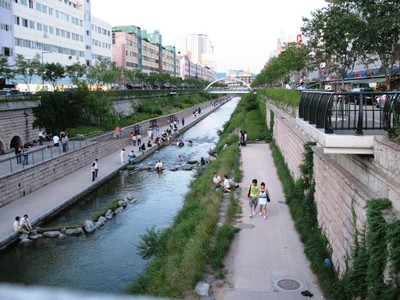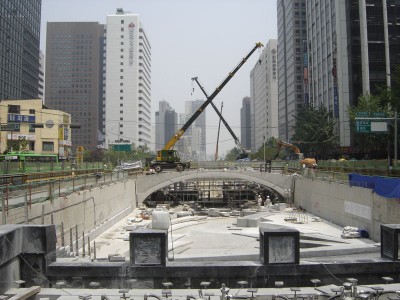Editor’s Note: This guest post was written by Kamala Rao, MCIP, Transportation Planner in Vancouver, BC, and a Sightline board member.
 As a sustainability-loving transportation planner, I was thrilled to learn that Dr. Kee Yeon Hwang would be visiting Vancouver and talking about the project that has made Seoul, Korea a legend in urban planning circles: the Cheonggyecheon Restoration Project.
As a sustainability-loving transportation planner, I was thrilled to learn that Dr. Kee Yeon Hwang would be visiting Vancouver and talking about the project that has made Seoul, Korea a legend in urban planning circles: the Cheonggyecheon Restoration Project.
What he and his colleagues accomplished—tearing down a busy, elevated freeway, re-daylight the river that had been buried beneath it, and creating a spectacular downtown green space, all in under two and a half years—is nothing short of amazing, not because it actually worked (there was plenty of evidence from other cities to suggest that it could), but because they were able to get public support for it. It’s the stuff urban planners dream about—not to mention a timeline for a major freeway project that would make Seattle drool.
I went to the lecture ready to record all the juicy stats I was sure he was going to throw out: peak hour traffic flows, mode shares, level of service, lane miles. What I got instead was a story told not in numbers and data, but a story about people and the profound impact the project had on the city.
The story of the Cheonggyecheon (pronounced chung-yay-chun) started hundreds of years ago during the reign of the Joseon Dynasty, when the kingdom’s castle was considered the “head” of Seoul and the river the “body”. That was its glorious past.
By the early 20th century as Seoul was burgeoning into the megacity of 10 million it is today, the river was bordered by a slum and used as a dumping ground, resulting in an eyesore of polluted water. As Dr. Hwang said, “sometimes it was blue, sometimes black, sometimes red.” It seemed a logical decision then, in the 1950s to cover it up and build a freeway over it. By 1976, the 4-lane elevated Cheonggyecheon Freeway—similar in form to Seattle’s Alaskan Way Viaduct—was standing as a symbol of successful industrialization and modernization of Korea.
What followed, however, was not only traffic, pollution, and the decline of downtown Seoul—which the river and then the freeway ran through the heart of—but also decades of horrible luck that befell a succession of Korean leaders. Some were shot to death, others imprisoned for bribery. It became known as the “Cheonggyecheon Curse.”
“If the sun is blocked, bad things happen,” Dr. Hwang tells us during his story—referring to the covered river.
 Fast-forward to 2001. As Dr. Hwang says, “some crazy people got together” and dreamed up the project. Hwang developed a traffic model to see what would happen if they took out what was considered a vital traffic artery carrying 168,000 cars per day. In the model he included adjustments to other streets and increased transit to see if Seoul could survive without the freeway. (Is this now sounding vaguely familiar to a particular proposal regarding the Alaskan Way Viaduct replacement, Seattle?).
Fast-forward to 2001. As Dr. Hwang says, “some crazy people got together” and dreamed up the project. Hwang developed a traffic model to see what would happen if they took out what was considered a vital traffic artery carrying 168,000 cars per day. In the model he included adjustments to other streets and increased transit to see if Seoul could survive without the freeway. (Is this now sounding vaguely familiar to a particular proposal regarding the Alaskan Way Viaduct replacement, Seattle?).
The results of the model surprised him: not only could it work, but it would actually improve travel times in downtown Seoul.
But the model was the easy part. Getting public and political buy-in was going to be harder—not to mention that people kept telling him this was “suicide” as a transportation planner and that if the project were built it would create, “gridlock!” and “traffic chaos!” (Yet another familiar refrain heard in Seattle when mention of the Transit and Streets proposal for replacing the Viaduct is made—not to mention other successful freeway removals in Portland, San Francisco, New York, and Milwaukee).
With a mayoral election coming up, Dr. Hwang and his “crazy” colleagues decided to shop the idea around to the candidates and found one willing to make it part of his central campaign platform: Lee Myung-bak. He ran on tearing down the elevated freeway and restoring the river—and won. There’s an ironic twist to the story at this point that made me happy to sacrifice all those stats in order to hear this fascinating tale: Lee Myung-bak had been the president of the construction company that built the freeway. Who better than he to admit it was a mistake to have been done in the first place?
It would seem from Dr. Hwang’s telling that political campaigns in Korea are strikingly similar to those in North America. Now that the election was over, he didn’t expect that the new mayor would actually make good on his promise. But to the contrary, the project was announced and commenced on his inauguration day. Dr. Hwang was swiftly appointed as the Director of the Research Center for the Cheonggyecheon Restoration Project at the Seoul Development Institute and was directed to complete what should’ve been a two-year design process in six months.
That isn’t to say that the project sailed through the public process. Far from it. In addition to the wary business-owners in the corridor (if they removed the cars, they were sure their business would go with it), there were 3,000 street vendors who made their living selling their wares to the people in those cars stuck in traffic—some even threatening to kill themselves if the project went forward. Fortunately the mayor anticipated the backlash and set up a staff of public engagement personnel just as large as the design team, and in the end, they were able to get enough support to begin construction, and the project was completed and opened to the public in 2005.
The results were nothing short of spectacular. The pictures tell the story better than any words can. In place of a blight-perpetrating freeway, the mayor created an astounding public amenity. A 3.6-mile linear, green river park that beautified downtown Seoul and gave its residents a spectacular setting in which to walk, splash, linger and truly enjoy the city.
But the success story doesn’t end there, Dr. Hwang went on to discuss the several other positive externalities that resulted from the Cheonggyecheon Restoration Project:
- A central business district revitalization plan is now underway
- Another elevated freeway in Seoul was removed and replaced with a surface street soon after
- A 16-lane road in Seoul was reduced by half and a massive public plaza built with the additional space
- A major street interchange in front of Seoul’s City Hall was replaced with a public plaza
- An urban streams renaissance spread across the country, with citizens everywhere wanting to restore their local rivers and streams
- Property values adjacent to the corridor increased by 300%
- Species of fish, birds, and insects have increased in and around the river
- The “urban heat island” effect was diminished in Seoul, with temperatures in the vicinity of the river on average 5.6 degrees F lower than surrounding areas
Oh—and there were two other “positive externalities” that resulted: Lee Myung-bak is now the President of Korea, and Dr. Kee Yeon Hwang is now the President of the Korea Transport Institute.
There is a big lesson here for Seattle and the rest of Cascadia as the region faces impending crises of diminishing funding for transportation construction and maintenance, rising fuel prices, diminishing air quality, and climate change: it can be done, and it has been done. Whether in Seoul or Portland or any of the many other cities where freeways
have been removed and not replaced—if even once had the cries of “gridlock!” and “traffic chaos!” ever come to fruition, then I might not be so confident that Seattle could do it too. But as Dr. Hwang and the citizens of Seoul will tell you, crazy ideas can work—with beautiful results at that.
Dr. Kee Yeon Hwang was in Vancouver as a visiting fellow at Simon Fraser University. He presented his public lecture, The Cheonggye Stream Revitalization Project: An Urban Transport Revolution in Seoul on March 29th at SFU’s Harbour Centre campus in Vancouver. He received his master’s degree in urban planning from the University of Oregon.
Completed restoration photo courtesy of flickr user madmarv00 under a Creative Commons license.
Construction photo courtesy of Wikimedia Commons.

Comments are closed.